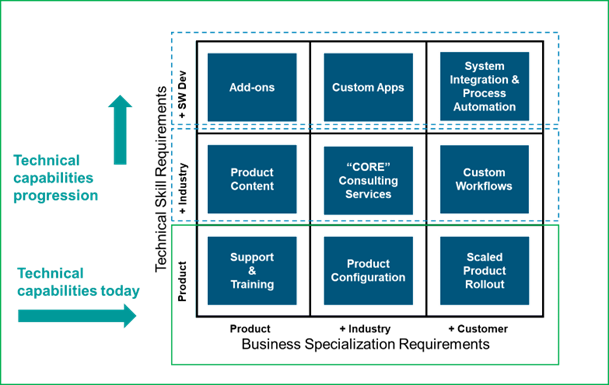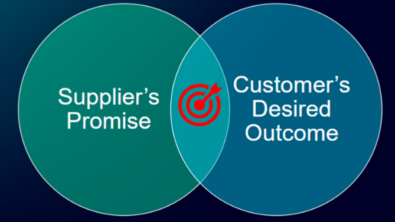Multiply profitability with a professional services practice

Your customers clearly want to purchase cloud-based solutions, making it vital for you to establish a services practice that provides the implementation, integration, customization and management of applications.
This article, the fourth in our five-part series on helping partners transform their businesses to SaaS, examines how to tap into unique technical expertise and resources to provide complete and profitable services as customers adopt Siemens solutions.
Explore the opportunities that are driven by customer needs and your business model
Traditionally, partners focus on the most apparent service needs when selling a solution to a first-time customer, such as installation and training. However, a holistic view of the customer’s business environment exposes opportunities far beyond the narrow scope of customer activation and reactive support.
Focusing on helping your customer address business needs rather than individual technical requirements, you open up opportunities to consult, design, deliver and maintain customer systems and capabilities. Software solutions and business applications are more complex than ever, meaning partners can sell and provide services that create meaningful competitive advantage and generate new revenue streams.
Though there are costs and efforts required to build a services practice, doing so will ultimately help sustain and grow your profitability while satisfying customer needs. The greater opportunity is best understood against a backdrop of declining product margins in a highly competitive cloud applications business model.
Calculate your priorities and focus on fast wins
Building a services practice is not a new priority, but it is more urgent than ever as the move to business in the cloud becomes more widespread. So, if the need and reward for building a services-centric business are so clear, the question remains: why have many partners not already built a services practice? The short answer is complexity plus confidence.
On one hand, specific operational and resource changes are required to build and run a services-based business. On the other hand, there are the accompanying investment requirements associated with the cloud/SaaS financial business model that introduce risk and unfamiliarity to an otherwise stable operation. These factors may seem daunting for partners who have built a business selling software solutions. Still, our experience shows that gradual, agile change can yield measurable rewards in the short term that sustain the effort of building a profitable practice in the long term.
No matter what services opportunities may eventually be possible, it is critical to prioritize short-term opportunities that generate fast wins. In other words, don’t wait until you have carefully planned every element of your services practice to get started. Pursue immediate opportunities where your customers have urgent needs, and you have existing capabilities. Small steps in each of the four essential elements of a services business will enable you to gradually invest and expand the scope of your services practice.
The four essential elements of a services practice
- Services business design – What form will your services business take: in-house resources, sub-contractors, strategic partners? How will you make money with services: what is the business value of the outcomes you will deliver? What kinds of engagements will you sell, and what is the format of your financial model: as-needed hourly work, flat rate projects, long-term contracts, recurring services? A clear understanding of the resources required and the revenue you can generate provides a reliable measurement of your intentions and progress toward key milestones.
- Service deliverable development – What specific technical/operational/business challenges will your customers pay to resolve? What specific service deliverables/outcomes will you provide? How will your team perform the services work? What is the scope of time and expense of each customer deliverable? Consider the services capabilities you can monetize in the “here and now” and design a roadmap for adding more deliverables over time. There is little value in waiting for some ideal capability that is reachable only in some far-off future scenario.
- Service engagement sales – How will you identify decision makers and their priorities that can be addressed via your services? How are services engagements packaged and priced? How will your sales reps be paid for services engagements? Look at what needs to be done differently in the sales process to engage customers in conversations around solutions and services. Train your team to sell the benefits of your expertise and capabilities and to overcome customer concerns.
- Service delivery and operations – How will you plan and manage services projects? What delivery resources will be required, and what is their bandwidth for delivering engagements? How will you handle customer expectations and experiences? It is not sufficient to have relevant technical skills or knowledge; you must organize your capabilities into manageable engagements and then complete your work according to specific metrics. Operating a services practice is structurally different from selling software.
Define your service offerings as packaged engagements and deliverables
The key to building a scalable services practice is to define services offerings that align with your customers’ needs. The biggest mistake is trying to do too much too soon. The best formula is to start with the services most closely related to your existing product and technical skills and align with your customers’ most urgent priorities.
It is vital to prioritize services offerings by:
- Depth of existing product/technical skills – assess where you have the most core technical knowledge today and how those capabilities align with customer needs
- Extent of specialization needed – identify industry requirements that can increase the complexity of meeting customer needs.

Before, during and after
We tend to think of services as something we do once a solution has been sold. But to fulfill your customers’ business goals, chargeable services should be be provided throughout the stages of the customer engagement lifecycle.
- During the pre-sales cycle – examples include solution design, consulting, proof of concept and value discovery with a phased implementation
- During the implementation of the solution – this can include solution configuration and testing, client deployments, user enablement, hypercare and data integration
- After the customer has adopted the solution – some typical examples include escalated support, systems management, changes to workflows and customizations
Can your customer’s employees drive optimal use to realize the business value of the solution you’re selling, or would they benefit from your expertise? In this context, the value of services takes on a “multiplier” effect that yields ongoing opportunities for growth and profitability. Your services business is not limited to a percentage of the value of each software license. In fact, each license creates many opportunities to provide meaningful value.
Build your services team and capacity one step at a time
The word “agile” was already mentioned in this article – and intentionally repeated here. Many may define “agile” as light, easy to move, supple or quick to respond. That is precisely how we advise partners to build services teams.

Focus on building a fully functioning, profitable, SaaS-based services practice one resource at a time. There is no need to make significant investments or hire multiple staff on Day 1. But you will eventually need to plan out the resources you will add, when you will add them and how you will profit from them. These are some questions you need to consider:
- Who will fulfill a services engagement? Does that person currently work for you? If so, will they need to be reassigned? Or will you need to make a new hire?
- What is the financial model for your first services engagements? How many hours/days will be required? How much will you charge? How long will it take to generate enough revenue to justify adding more delivery headcount?
- What is the sales process for winning your first services opportunities? Will you leverage existing sales reps? If so, will you need to redefine their responsibilities to create bandwidth for services engagements? Or will you integrate services sales into the solution sales process, allowing reps to easily add services to software license sales?
- What is customer relationship management process in a services engagement? Will services staff provide project management and customer updates, or will you allocate a specific project manager? How will you manage multiple projects and engagements at the same time?
Embrace an agile business development method to grow your services practice by:
- Maintaining an agile attitude – Plan a rapid series of incremental improvements and avoid overreach, even if large improvements appears attainable at first glance
- Shaping the path – Create an environment that limits required decisions and have a clear roadmap with built-in provisions for potential “what-if” scenarios
- Engaging the people – Define specific roles/actions/skills early on along with expectations, being sure to recognize early progress
- Connecting with the heart – Understand and align with internal motivations, creating a sense of ownership among employees while emphasizing how strategic services are to the health of the business
There is a twofold benefit for a partner who builds a comprehensive, fully functioning services practice:
- Services create a new means to generate lucrative and profitable revenue.
- Services align with the growing customer demand for cloud-based service offerings.
Building an effective and scalable services practice is the most reliable way to ensure a successful business operation that allows you to remain viable and relevant to your customer base amidst ongoing disruption in our highly competitive market. Start your plan today, and engage with your Siemens resources to accelerate your journey.
Keep an eye out for our fifth and final blog in the series: Building a customer success capability to drive consistency and scalability.
The first three blogs in the series include: Achieving fast, tangible results transforming your partner business to SaaS – a report from the real world, Transformation to SaaS – Building a financial and operational strategy for transformation and Build a sales and marketing engine that thrives in a SaaS world
About the authors
Toni Reszka is Director of Global Partner enablement at Siemens Digital Industries Software. He has over 30 years of experience in partner business development and managing several major partners across international territories. He is currently leading Siemens’ XPE program, which helps partner businesses transform to XaaS.
Ryan Morris is Principal Consultant for Morris Management Partners. He has more than 25 years of experience in sales, marketing and management in the B2B technology solutions industry – specifically focused on building successful multi-tier channel solutions and profitable solution provider businesses.


